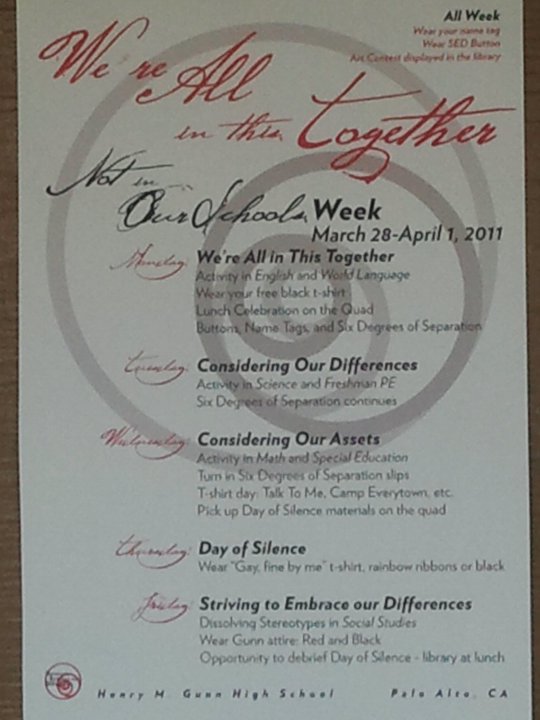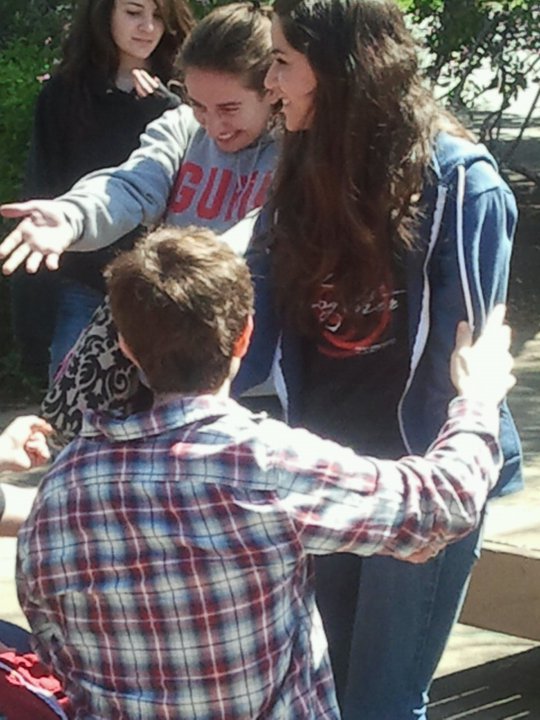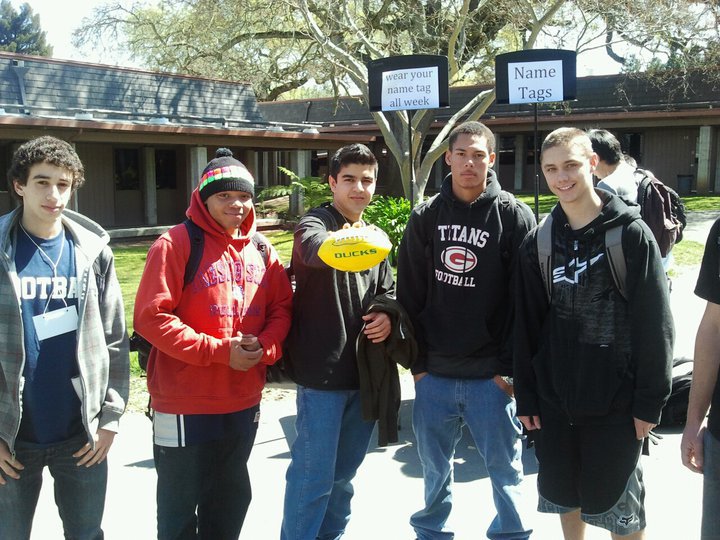“NIOS Week lessons in the classroom are really powerful because the teachers and students share experiences. This creates a greater sense of connectedness between classmates, teachers and the school,” NIOS co-facilitator Todd Summers told the Gunn High School newspaper, The Oracle, earlier this year.
Though Gunn High School in Palo Alto, Calif. has been holding a Not In Our School week for nearly a decade, this year has been particularly successful. Part of this year’s success can be attributed to the number of departments that participated in Not In Our School activities, bringing these important conversations into their individual classrooms. Gunn teachers provided a website with a breakdown of activities by department with resources. Below, these teachers reflect on their lessons during Not in Our School week.
2011 Not In Our Schools Week Highlight Lessons
—Gunn High School Not In Our School team
 Many teachers participated in NIOS by doing a lesson in their classroom. The lessons below are just a snapshot of some of the feedback on the amazing experiences teachers and students had in classrooms. These anonymous comments come from brave teachers who taught a lesson during NIOS and are meant to be a reflection of the types of activities that happened across campus during the week. Thanks to everyone who participated.
Many teachers participated in NIOS by doing a lesson in their classroom. The lessons below are just a snapshot of some of the feedback on the amazing experiences teachers and students had in classrooms. These anonymous comments come from brave teachers who taught a lesson during NIOS and are meant to be a reflection of the types of activities that happened across campus during the week. Thanks to everyone who participated.Monday: English and World Language Departments
English: “I showed my 9/10 Lit Style class one of the ‘What Would You Do?’ videos (Latino man being beat up in New Jersey) to very good effect. One student said, ‘I think it's great we are learning about these things in this school. At my old school, which was in a violent and dangerous area, we never learned anything about this.’”
World Language: “We are studying clothes, so I used that as a springboard to discuss judgments we make about others based on what they wear. How do clothing choices change from high school to middle school? How do we decide to like or not like a person based on clothes. It led into the idea that what you really are is inside of you, and only by getting to know someone can you find out about them—the students did a good job processing this idea.”
Tuesday: P.E. and Science Departments
Science: “I didn’t intend to use the whole period, but it just ended up that way. I started by changing their seats so they were separated by gender and then I asked them to create a T-chart with how males and females are different, allowing them to speak from their own experience as well as generally accepted stereotypes. I collected their charts and put some of their answers on the board. In G period I just put up the girl’s contributions without telling them. This prompted a bit of discussion including how most stereotypes are created and/or perpetuated by men. When I told them that I had only put up the girl’s contributions, they were surprised.
“We then watched the TED talk on women in executive positions, which I thought was very good. One male student thought it was men bashing, and unfortunately we didn’t have time to discuss that further. We talked more about the different attributes from our stereotypes list and how they might affect a woman’s chance of getting an executive position and perhaps more importantly if she would want one or would even try for one. At the end of the discussion I had the students reflect on a slip of paper what they thought of the discussion, what they would have contributed if they didn’t get a chance, or any other thoughts they had.”
Physical Education: “All freshmen classes went through a learning disabilities activity led by an outside facilitator. P.E. teachers felt it was a successful addition to the week.”
 Wednesday: Math and Special Ed Departments
Wednesday: Math and Special Ed DepartmentsMath: “In my Alg1A/Geo A classes I had the students do Activity #2 of You're Not Alone where I had them answer the six questions with their heads down and look at the results and comment. Interesting feedback from the students that Gunn is diverse yet students are still unfairly judged. Then, I had them think of an experience where they felt unfairly judged or discriminated against or so forth. Then, I had the students do a partner share and then a class share. It went really well and the kids were responsive. I did have some students who had experiences that we could all learn from and I did have one student that I had to talk to outside of the classroom during the activity because it really hit home.”
Special Ed: “We did ‘Silent Beats’ in English. I showed all of Straightlaced to my F period study skills; these squirmy boys were really involved. Tomorrow in English I'm going to show part of Straightlaced, so they get the flavor of the film, and show the segment ‘Ray’ on Friday. In Government, I went through the initiative and court process using Prop 8 as a model.”
Thursday: Day of Silence
Some teachers did lessons around the Day of Silence earlier in the week. Some teachers also observed the Day of Silence in their classroom, with the help of a PowerPoint put together by Daisy Renazco.
Visual/Performing Arts: “It was the best year yet to honor the Day of Silence. Students were respectful, the slide presentation Daisy sent out last year was VERY helpful. I prepared them the day before and then watching them think about why we were doing this as a school.
“It really helped them to have several of their teachers participating in it (I talked to a couple students after school), so I'd be happy to talk with teachers next year who can't figure out how to do it, cause it did take me three years to do it well, it just takes more thought and preplanning (which I know can be the straw...I came to it fresh!)
“Friday we will debrief their experience to follow up. I have some freshman boys who REALLY needed to have these issues of discrimination put in front of their face, with respect.”
Friday: Day of Silence Debriefing and Social Studies (Dissolving Stereotypes)
 English: “The video of the high school student who came out to her entire school (shown at the end of the Friday morning announcements) was a wonderful impetus for classroom discussion. Not only did my B-period class have an incredibly rich discussion -- lasting the entire period -- but my G-period class wanted to discuss it, as well.”
English: “The video of the high school student who came out to her entire school (shown at the end of the Friday morning announcements) was a wonderful impetus for classroom discussion. Not only did my B-period class have an incredibly rich discussion -- lasting the entire period -- but my G-period class wanted to discuss it, as well.”Social Studies: “We had a lively discussion about racism and discrimination (age, race, language) before watching ‘What Would You Do?’ videos. Students shared their experiences and observed the trend of being 'followed' in a store because of how one is dressed/looks is pretty common but demeaning nonetheless.”